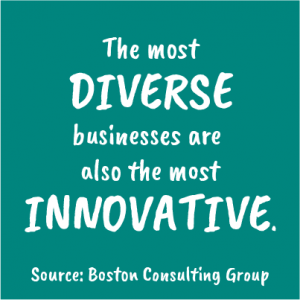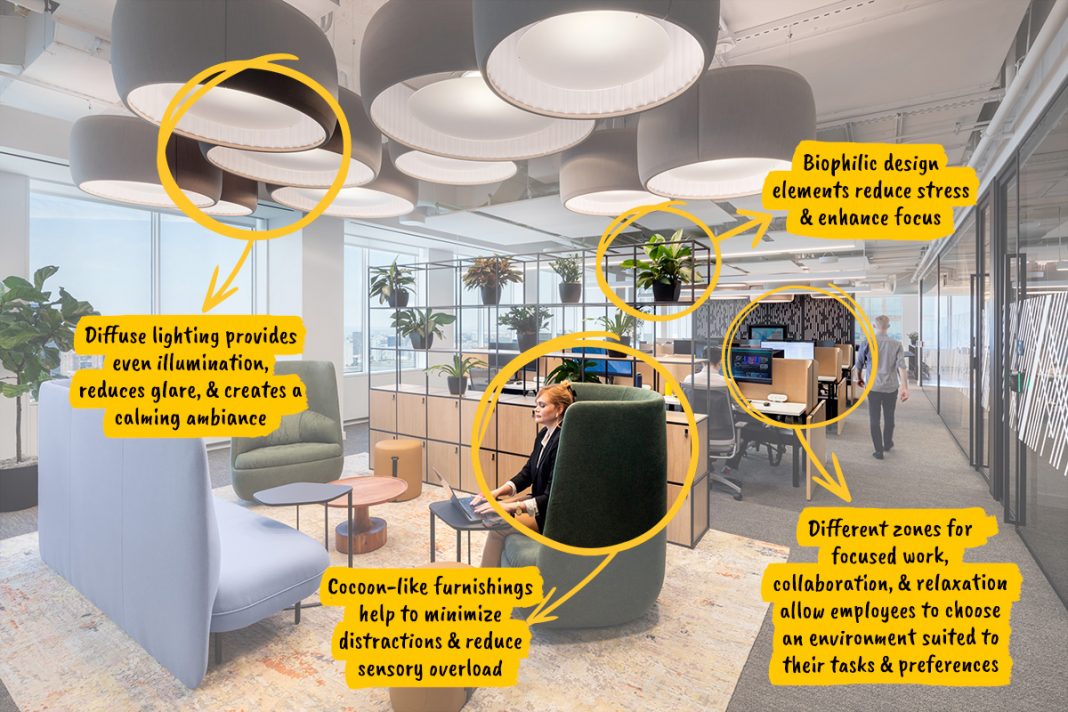The Perkins Eastman’s Design Strategy team sat down with Armita Hosseini, a registered psychological associate and a member of the College of Psychologists of Ontario specializing in neurodivergent conditions including autism and ADHD, to understand how architects and designers can create more inclusive workplace environments.
There is no standard normal. Normal is subjective. There are seven billion versions of normal on this planet.
– Matt Haig
Imagine your workstation sits in the middle of a construction site: Hard hat workers in orange vests are shouting over the din of hammering and sawing. You’re surrounded by towering cranes, swinging steel beams, and the relentless pounding of heavy machinery.
For employees with neurodivergent wiring, working in an ordinary office might feel just as overwhelming as trying to get things done in an active demolition zone. Typical annoyances like noisy coworkers, harsh fluorescent lighting, and cramped workstations could make it nearly impossible for some individuals to focus, stay organized, or manage stress on a day-to-day basis.
It’s estimated that 15 to 20% of the population is neurodivergent. And yet, office design standards often fail to support the broad spectrum of differences in how people work, learn, and experience the world. This is a missed opportunity to drive innovation, boost productivity, and build a workplace where every employee can perform at their best.

Everyone is Neurodiverse
The terms “neurodivergent” and “neurodiverse” are sometimes used interchangeably, but they have distinct meanings. Neurodivergent describes individuals whose brains function differently from what is considered “typical.” It includes people with clinical conditions like Autism Spectrum Disorder (ASD) and Attention Deficit Hyperactive Disorder (ADHD), but it also encompasses a wide range of other cognitive differences.
 Neurodiversity, on the other hand, refers to the entire spectrum of differences across all human brains. Armita Hosseini, a psychologist specializing in neurodivergent conditions and clinic director of Talk and Thrive, points out that no two brains are exactly alike. Even for those with “typical” attributes, there are differences in how they sense, perceive, and interpret their experiences.
Neurodiversity, on the other hand, refers to the entire spectrum of differences across all human brains. Armita Hosseini, a psychologist specializing in neurodivergent conditions and clinic director of Talk and Thrive, points out that no two brains are exactly alike. Even for those with “typical” attributes, there are differences in how they sense, perceive, and interpret their experiences.
According to Hosseini, designing for “average” leaves important human resources on the table. Neurodivergent individuals often have high levels of creativity, and their talents can provide a lot of value in the workplace. But when they’re thrown into an environment that isn’t a good fit, their unique contributions can go untapped.
The Business Case for Inclusive Design
Companies spend as much as 70% of their total operating costs on labor. This leads to the important question: Why invest so much in your workforce and only tap into a fraction of its potential?
 Inclusive design and practices unlock that potential by helping everyone perform at their best. Research strongly supports the business case for these investments, linking workplace diversity to higher employee engagement, innovation, and productivity, among other positive outcomes:
Inclusive design and practices unlock that potential by helping everyone perform at their best. Research strongly supports the business case for these investments, linking workplace diversity to higher employee engagement, innovation, and productivity, among other positive outcomes:
- In a global study of more than 1,700 companies, Boston Consulting Group found that the most diverse businesses were also the most innovative
- Deloitte determined that organizations with inclusive cultures are 2x as likely to meet or exceed financial targets, 3x as likely to be high-performing, and 8x more likely to achieve better business outcomes
- According to Accenture, businesses with strong inclusion practices have 28% higher revenue and 30% higher profit margins
- Analysis by Pew Research found 56% of U.S. workers say focusing on diversity, equity, and inclusion efforts at work is a good thing
 “Accommodations for neurodiversity are well worth the investment—and less costly than hiring and training new employees,” says Hosseini, noting that the objective isn’t to design specifically for the relatively small percentage of people with autism or ADHD. Rather, it’s about creating flexible environments with plenty of variety so that everyone is enabled to do their best work.
“Accommodations for neurodiversity are well worth the investment—and less costly than hiring and training new employees,” says Hosseini, noting that the objective isn’t to design specifically for the relatively small percentage of people with autism or ADHD. Rather, it’s about creating flexible environments with plenty of variety so that everyone is enabled to do their best work.
Many of the accommodations for neurodivergent individuals are beneficial for the neurotypical population as well.
“For example,” Hosseini says, “we know that autistic people really benefit from nature. In an office, it might be as simple as having potted plants or landscape paintings. There might be a greater sensitivity to light or sound, so you want to have soft or natural lighting and sound-reducing materials. And it’s good to have furnishings that let people move around and change postures.”
Neurodiversity creates more opportunities for creativity and innovation, says Hosseini. With a more supportive office environment and inclusive policies, companies can realize greater returns on their human investments.

Three Ideas to Unlock Employee Potential
Looking at the office, Hosseini suggests three categories to consider:

Neurodivergent individuals may be more sensitive to sensory stimuli. Obvious culprits are light, noise, texture, and temperature, but subtler factors like the choice of upholstery fabrics, color schemes, and surface materials also come into play. Hosseini points out that for some people, understimulation—or too little sensory input—can be just as distressing as overstimulation.
Design considerations:
- Provide variety and choice with spaces designed for low, medium, and high sensory stimulation
- For low-sensory zones, create a calming atmosphere with diffused lighting, soundproofing, adjustable panels between workstations, and quiet zones
- Keep the environment tidy and uncluttered to reduce visual distractions
- For high-sensory spaces, incorporate movement-friendly areas, engaging visuals, varied work points, and interactive furnishings (e.g. wobbly chairs, hammocks or swings, adjustable-height desks)

Different people have different communication preferences. Neurodivergent individuals may find non-verbal cues or figurative language difficult to understand. For this reason, explicit instructions and clear expectations—reinforced in writing—can be helpful.
- Incorporate visual cues like directional signage, maps, or color-coded floor graphics to support wayfinding
- Use multiple channels for company-wide communications, e.g. email newsletters, digital bulletin boards, in-person town halls, etc.
- For virtual meetings, provide multiple platforms for communication to allow everyone to contribute to the conversation on equal footing
- Provide written meeting agendas and summaries to allow participants to prepare in advance and review key points after the meeting
- Provide clear written expectations for meeting etiquette, desk-sharing, and other common workplace interactions

“We all benefit from having some degree of routine,” says Hosseini “but it’s especially important for neurodivergent individuals as it builds predictability.” Environmental cues can help guide employees through transitions, task or work setting to another.
Design considerations:
- In a hybrid work scenario, make sure all work points have a consistent setup—for example, provide the same tools and equipment at every workstation and a predictable, user-friendly system for reserving desks
- Display visual schedules in common areas
- Include designated transition zones where employees can reset before moving to a new task or meeting
- Promote routine and structure, and provide plenty of advance notice for changes that will impact employees’ day-to-day schedule
- Establish arrival and closeout routines to help employees start and end their workday; for example, providing a checklist for setting up and shutting down workstations can reduce anxiety and create a sense of order and control
Notes on Neurodiversity:
The term “neurodivergent” includes people with clinical conditions like Autism Spectrum Disorder (ASD) and Attention Deficit Hyperactive Disorder (ADHD), but it also encompasses a wide range of other cognitive and learning differences.
Neurodiversity describes the natural variation that exists across the entire population. No two brains are alike, even “typical” ones!
According to the CDC:
- The prevalence of ADHD among adults in the U.S. is 4.4%;
- Approximately 2.2% of adults in the U.S. have AS
Disability or Talent?
Research supports the argument that certain neurodivergent conditions could manifest as strengths or disabilities depending on the person-environment fit: “In highly social and unpredictable environments some of their differences may manifest as disabilities, while in more autism-friendly environments [differences are allowed to] blossom as talents.” Source: The Concept of Neurodiversity Is Dividing the Autism Community | Scientific American

Armita Hosseini is a registered psychological associate and member of the college of Psychologists of Ontario (CPO) and the clinic director of her own clinical practice, Talk and Thrive Psychology. She is a member of the International Society for Autism Research (INSAR), Canadian Psychological Association (CPA), and Ontario Psychological Association (OPA). Ms. Hosseini specializes in clinical and counseling psychology with expertise in Autism Spectrum Disorder (ASD), Attention Deficit Hyperactivity Disorder (ADHD) and other neurodevelopmental disorders.
All Images Copyright Perkins Eastman unless otherwise noted.


